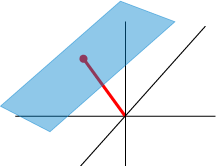Section3.2Week 6 (Jul 2-6)
In Chapter 3, we will complete our journey through the properties of the linear system of equations \(A{\bf x} = {\bf b}\) by studying invertible linear transformations. These are the transformations that can be "undone," and correspond to square matrices which can be "cancelled" from both sides of the equation via multiplication by the inverse matrix \(A^{-1}\text{:}\)
\begin{align*} A{\bf x} \amp= {\bf b}\\ A^{-1} \; A{\bf x} \amp= A^{-1} \; {\bf b}\\ {\bf x} \amp= A^{-1}\; {\bf b}. \end{align*}Because the above solution both:
- Works for any vector \({\bf b}\text{,}\) and
- Produces a unique answer \({\bf x} = A^{-1}{\bf b}\text{,}\)
we recognize from Chapter 2 that invertible matrices must be exactly those for which a unique solution to \(A{\bf x} = {\bf b}\) always exists.
This week we'll put most of the focus on the practical considerations from Section 3.1: how to tell when a matrix has an inverse, and how to compute and use that inverse? After that we'll begin to look at how invertible matrices can be used to define systems of coordinates and, importantly, also be used to relate different systems of coordinates one to another. This is a much longer story, and will be a common thread in the whole rest of the course -- we'll only get a quick introduction this week in Section 3.2.
To do this week:
By Monday 7/2:
- Submit Portfolio 2 via Blackboard.
By Thursday 7/5:
- Read and annotate 3.1: Invertibility https://via.hypothes.is/http://merganser.math.gvsu.edu/david/linear.algebra/ula/ula/sec-matrix-inverse.html
- Read and annotate 3.2: Bases and Coordinate Systems https://via.hypothes.is/http://merganser.math.gvsu.edu/david/linear.algebra/ula/ula/sec-linear-dep.html
- NB: I recommend working out the Activities in these sections especially. Instructor's answers are posted in Hypothes.is that you may use both as a reference and as discussion fodder in your readings.
By Friday 7/6:
- Watch for Lecture 6 on this page.
- Submit Quiz 6 via Blackboard.
Subsection3.2.1What Kinds of Matrices have Inverses?
Additional content in Subsection 2.3.2.
